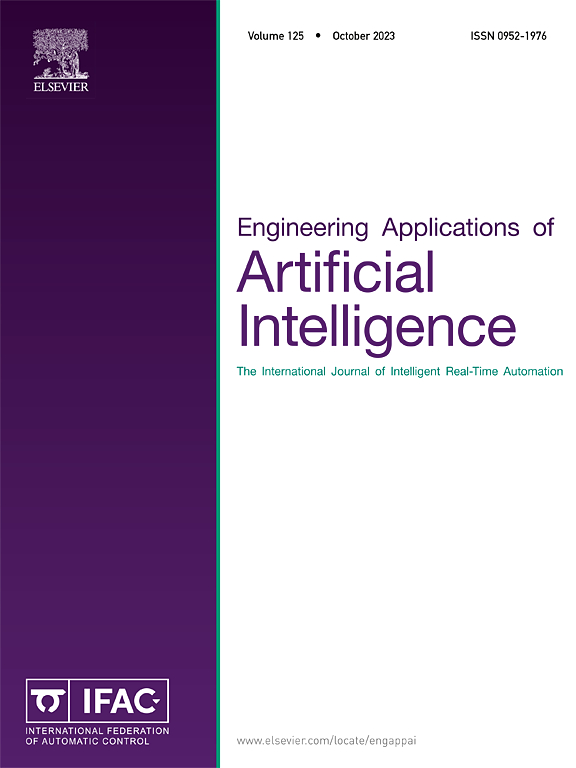Multi-objective weighted average algorithm: a novel algorithm for multi-objective optimization problems and its application in engineering problems
IF 8
2区 计算机科学
Q1 AUTOMATION & CONTROL SYSTEMS
Engineering Applications of Artificial Intelligence
Pub Date : 2025-07-02
DOI:10.1016/j.engappai.2025.111569
引用次数: 0
Abstract
Numerous meta-heuristic algorithms struggle with degraded performance when addressing multi-objective optimization problems due to the challenge of balancing two goals: accurately estimating Pareto-optimal solutions and ensuring their broad distribution across objectives. While the Weighted Average Algorithm (WAA) excels in single-objective optimization, its scalarization-based mechanism fundamentally conflicts with multi-objective requirements. To bridge this gap, we propose the Multi-Objective Weighted Average Algorithm (MOWAA) with three key innovations: (1) a hybrid exploration-exploitation mechanism integrating adaptive mutation and crossover operations; (2) an elitist archive management system using efficient non-dominated sorting across three critical solution sets; and (3) a novel roulette-wheel-based leader selection strategy that dynamically balances convergence and diversity. To verify the performance of the developed MOWAA, the numerical benchmark test functions (CEC2009, ZDT and DTLZ) and four engineering problems (the Binh and Korn (BNH), Constraint (CONSTR), Srinivas and Deb (SRN), and 10-bar Truss (BAR TRUSS)) are used in comparison with three multi-objective optimization algorithms. The results show that MOWAA achieves better optimization performance than comparative algorithms, with Pareto-optimal solutions exhibiting excellent convergence and coverage. Finally, applying MOWAA to an Artificial Neural Network (ANN) model using an experimental dataset on surface waviness (in mm) of Wire Arc Additive Manufacturing (WAAM) components enhances predictive accuracy by balancing optimization of prediction error and variance. Compared to single-objective optimization methods, the MOWAA approach effectively captures the complex relationships between process parameters and waviness in the WAAM process.
多目标加权平均算法:一种求解多目标优化问题的新算法及其在工程问题中的应用
许多元启发式算法在处理多目标优化问题时,由于平衡两个目标的挑战而导致性能下降:准确估计帕累托最优解并确保其在目标之间的广泛分布。加权平均算法(WAA)在单目标优化方面具有优势,但其基于尺度的机制与多目标需求存在根本冲突。为了弥补这一差距,本文提出了多目标加权平均算法(MOWAA),并进行了三个关键创新:(1)融合自适应突变和交叉操作的混合探索-开发机制;(2)一个精英档案管理系统,在三个关键解集上使用高效的非支配排序;(3)一种基于轮盘赌的动态平衡收敛性和多样性的领导者选择策略。为了验证所开发的MOWAA的性能,使用了数值基准测试函数(CEC2009、ZDT和DTLZ)和4个工程问题(Binh and Korn (BNH)、Constraint (CONSTR)、Srinivas and Deb (SRN)和10杆桁架(BAR Truss))与3种多目标优化算法进行了比较。结果表明,MOWAA算法的优化性能优于比较算法,pareto最优解具有良好的收敛性和覆盖性。最后,利用电弧增材制造(WAAM)部件表面波纹度(mm)实验数据集,将MOWAA应用于人工神经网络(ANN)模型,通过平衡预测误差和方差的优化,提高了预测精度。与单目标优化方法相比,MOWAA方法有效地捕捉了WAAM过程中工艺参数与波动度之间的复杂关系。
本文章由计算机程序翻译,如有差异,请以英文原文为准。
求助全文
约1分钟内获得全文
求助全文
来源期刊

Engineering Applications of Artificial Intelligence
工程技术-工程:电子与电气
CiteScore
9.60
自引率
10.00%
发文量
505
审稿时长
68 days
期刊介绍:
Artificial Intelligence (AI) is pivotal in driving the fourth industrial revolution, witnessing remarkable advancements across various machine learning methodologies. AI techniques have become indispensable tools for practicing engineers, enabling them to tackle previously insurmountable challenges. Engineering Applications of Artificial Intelligence serves as a global platform for the swift dissemination of research elucidating the practical application of AI methods across all engineering disciplines. Submitted papers are expected to present novel aspects of AI utilized in real-world engineering applications, validated using publicly available datasets to ensure the replicability of research outcomes. Join us in exploring the transformative potential of AI in engineering.
 求助内容:
求助内容: 应助结果提醒方式:
应助结果提醒方式:


